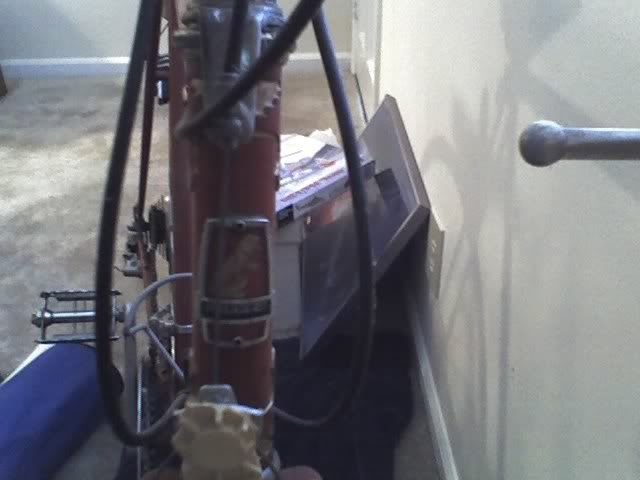For those of you keeping track, I am posting a fair number of posts here in rapid succession. This will likely be the case until I am caught up to where I am currently in the rebuild process.
When I received the bike from Lefty and
Isus, I was working in a bike shop in
Carrboro. Which meant I had access to the Shop area, and the tools therein. (A huge boon for a rebuild!) The kind folks that run the shop, as well as the mechanics, welcomed me to begin my project by taking the bike apart.
What happened next was a three-hour adventure in rust, grease, and loose ball bearings.
For those of you not familiar with North Carolina, we have a lot of red clay here in our soil. A LOT OF RED CLAY. Which permeates most anything left outdoors after a period of time. Friends, when I opened up the bottom bracket, the grease was reddish-orange, caked and clotted, and the ball bearings were sealed in the death-grip of the stuff.
As I went through the parts, I kept a running list in my head of what looked salvageable, and what did not. Little did I know how important some things were going to become later, especially given the french construction of this bike.
The wheels were shot. The rims and hubs were both rusted, and one rim was slightly bent. The bars were almost solidified to the stem, and the bar wrap refused to come completely off without the threat of fire. The cables were caught in their housings. The rear derailleur was in working order, but of course, I had already decided to go single-speed with the rebuild. The cranks were
Stronglight TS models, quite good quality, and still in very nice shape. I'll be reusing them. The pedals were alright, french
Lyotard 136 touring pedals. I kept them, but was undecided on if I'd use them. The seat & seat post went in the bin. I knew I would be replacing the seat with some variety of
Brooks leather saddle. The brakes were Swiss-made
Weinmann center-pull brakes, complete and in working order, so I'll be keeping them. The shifters were Simplex, and in good working order, but I won't need them. (I kept them for possible resale.)
After much haranguing, I was able to get the stem, bars and headset off. Luckily, the fork
steerer is the slotted AND threaded type, allowing me to use pretty much any one-inch headset I want; the bearings and races were loose, and I will replace them with sealed bearings when I rebuild the front end.
Overall, I threw a lot away. I kept the frame, fork, cranks, pedals,
chainrings, brakes, and some other small fittings which were still in good shape. I was able to safely remove the near-pristine
headbadge. I was sad to lose the wheels, but there was nothing for it. One of the mechanics said he would happily lace up a new set for me on the cheap, if I provided the rims and hubs.
During this time, I had also done some research. Thanks to the kind folks at
Retro Peugeot, I discovered that the bike in my hands was a 1978
UO-8 Touring model. It was made with Peugeot Lightweight Steel (usually Reynolds 501) which is generally well-regarded by restorers and builders. The geometry of the bike, especially the trail and shape of the forks, was a typical French design intended for carrying weight, and rolling smoothly, as well as making steering easy. The bike was originally silver metallic. As of this writing, the remaining parts are in my car, awaiting cleaning and polishing.
A design theme was coming together in my noggin. I wanted something classic, that rode upright, and would carry my groceries. Something that would make a statement, but also be a practical, all-purpose around-town bike. And thankfully, History had an answer for me. More on that in coming posts!










